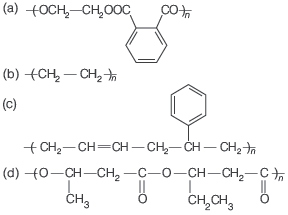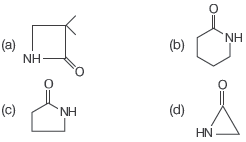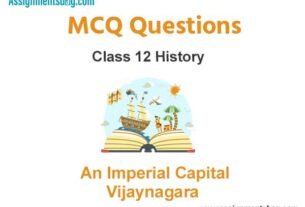Please refer to MCQ Questions Chapter 15 Polymers Class 12 Chemistry with answers provided below. These multiple-choice questions have been developed based on the latest NCERT book for class 12 Chemistry issued for the current academic year. We have provided MCQ Questions for Class 12 Chemistry for all chapters on our website. Students should learn the objective based questions for Chapter 15 Polymers in Class 12 Chemistry provided below to get more marks in exams.
Chapter 15 Polymers MCQ Questions
Please refer to the following Chapter 15 Polymers MCQ Questions Class 12 Chemistry with solutions for all important topics in the chapter.
MCQ Questions Answers for Chapter 15 Polymers Class 12 Chemistry
Question. Which one of the following can be used as a monomer in a polymerisation reaction?
(a) CH3CH2Cl
(b) CH3CH2OH
(c) C6H6
(d) C3H6
Answer
D
Question. The catalyst used in the manufacture of polyethylene by Ziegler method is
(a) titanium tetrachloride and triphenyl aluminium
(b) titanium tetrachloride and triethyl aluminium
(c) titanium dioxide
(d) titanium isopropoxide
Answer
A

Answer
A
Question. The polymer containing strong intermolecular forces e.g. hydrogen bonding,
(a) teflon
(b) nylon-6,6
(c) polystyrene
(d) natural rubber
Answer
B
Question. Which of the following fibres is madeup of polyamides?
(a) Dacron
(b) Orlon
(c) Nylon
(d) Rayon
Answer
C
Question. Which of the following fibres is madeup of polyamides?
(a) Dacron
(b) Orlon
(c) Nylon
(d) Rayon
Answer
C
Question. Which of the following fibres is madeup of polyamides?
(a) Dacron
(b) Orlon
(c) Nylon
(d) Rayon
Answer
C
Question. Buna-N-asynthetic rubber is a copolymer of

Answer
C
Question. Which of the following contains isoprene units?
(a) Natural rubber
(b) Nylon-6,6
(c) Polyethylene
(d) Dacron
Answer
A
Question. The species which can best serve as an initiator for the cationic polymerisation is
(a) LiAlH4
(b) HNO3
(c) AlCl3
(d) BaLi
Answer
C
Question. Urethane is

Answer
D
Question. Polymer formation from monomers starts by
(a) condensation reaction between monomers
(b) elimination reaction between monomers
(c) conversion of monomer to monomer ions by protons
(d) hydrolysis of monomers
Answer
A
Question. Which of the following is fully fluorinated polymer?
(a) PVC
(b) Thiokol
(c) Teflon
(d) Neoprene
Answer
C
Question. In which of the following polymers, ethylene glycol is one of the monomer units?

Answer
A
Question. Soft drink bottles and baby feeding bottles are generally made up of
(a) polyester
(b) polyurea
(c) polyamide
(d) polystyrene
Answer
D
Question. Which of the following monomers gives the polymer neoprene on polymerisation?
(a) CH2 ==CHCl
(b) CCl2 == CCl2
(c) CH2 == CCl — CH ==CH2
(d) CF2 ==CF2
Answer
C
Question. The compound that inhibits the growth of polymer chain during vinyl polymerisation, is
(a) carbon tetrachloride
(b) p-benzoquinone
(c) benzophenone
(d) carbon dioxide
Answer
B
Question. Which of the following is not correctly matched?

Answer
C
Question. Which of the following monomers will react fastest in cationic polymerisation?
CH2 == CH—CH3, CH2 == C(CH3)2 , CH2 == CH—CH(CH3)2
(I) (II) (III)
(a) Only I
(b) I, II and III
(c) Only II
(d) I and III
Answer
C
Question. Which of the following contains ester linkage?
(a) Nylon-6,6
(b) Dacron
(c) Bakelite
(d) PVC
Answer
B
Question. Which of the following polymer is biodegradable?

Answer
C
Question. In which of the following polymers, empirical formula resembles with monomer?
(a) Bakelite
(b) Teflon
(c) Nylon-6,6
(d) Dacron
Answer
C
Question. The polymer used for optical lenses is
(a) polypropylene
(b) polyvinyl chloride
(c) polythene
(d) polymethyl methacrylate
Answer
D
Question. Which of the following polymer is a polyamide?
(a) Terylene
(b) Nylon-6,6
(c) Rubber
(d) Vulcanised rubber
Answer
B
Question. Match the Columns and choose the correct option.

Codes
A B C D
(a) 3 1 2 4
(b) 1 2 4 3
(c) 4 1 2 3
(d) 1 4 3 2
Answer
A
Question. Polymer used in bullet proof glass is
(a) PMMA
(b) lexan
(c) nomex
(d) kevlar
Answer
B
Question. Polymer obtained by condensation polymerisation is
(a) polythene
(b) teflon
(c) phenol-formaldehyde
(d) nitrile rubber
Answer
C
Question. The catalyst used for the polymerisation of olefins is
(a) Ziegler-Natta catalyst
(b) Wilkinson’s catalyst
(c) Pd-catalyst
(d) Zeolite
Answer
A
Question. Synthetic human hair wigs are made from copolymerisation of vinyl chloride and acrylonitrile and is called
(a) PVC
(b) polyacrylonitrile
(c) cellulose
(d) dynel
Answer
D
Question. Which of the following statements about low density polythene is false?
(a) It is a poor conductor of electricity
(b) Its synthesis required dioxygen or a peroxide initiator as a catalyst
(c) It is used in the manufacture of buckets, dustbins etc
(d)Its synthesis requires high pressure
Answer
C
Question. Lactum from which nylon-4 is synthesised is

Answer
C
Question. Which one is classified as a condensation polymer?
(a) Dacron
(b) Neoprene
(c) Teflon
(d) Acrylonitrile
Answer
A
Question. Glyptal polymer is obtained from glycol by reacting with
(a) malonic acid
(b) phthalic acid
(c) maleic acid
(d) terephthalic acid
Answer
B
Question. Thermosetting polymer, bakelite is formed by the reaction of phenol with
(a) CH3CH2CHO
(b) CH3CHO
(c) HCHO
(d) HCOOH
Answer
C
Question. Among cellulose, polyvinyl chloride, nylon and natural rubber, in which of the polymer intermolecular force of attraction is weakest?
(a) Nylon
(b) Polyvinyl chloride
(c) Cellulose
(d) Natural rubber
Answer
D
Question. Natural rubber is which type of polymer?
(a) Condensation polymer
(b) Addition polymer
(c) Coordination polymer
(d) None of these
Answer
B
Question. The catalyst used for olefin polymerisation is
(a) Ziegler-Natta catalyst
(b) Raney nickel catalyst
(c) Wilkinson catalyst
(d) Merrifield resin
Answer
A
Question. Buna-N synthetic rubber is a copolymer of

Answer
C
Question. The polymer which is used in non-sticky kitchenwares is
(a) PVC
(b) teflon
(c) rayon
(d) isoprene
Answer
B
Question. The monomers used for the preparation of nylon 2-nylon 6 is/are
(a) caprolactam
(b) alanine and aminocaproic acid
(c) glycine and aminocaproic acid
(d) hexamethylenediamine and adipic acid
(e) glycine and amino valeric acid
Answer
C
Question. Synthetic rubber is
(a) polyisoprene
(b) polychloroprene
(c) polythene
(d) polyesters
Answer
B
Question. Terylene is a polymer obtained from
(a) ethylene glycol and glycerol
(b) ethylene glycol and glyceraldehyde
(c) ethylene glycol and terephthalic acid
(d) None of the above
Answer
C
Question. Teflon polymer is formed by the polymerisation of
(a) CH2 = CH—CN
(b) F2C = CF2
(c) Cl2C=CH2
(d) H2C=CHCI
Answer
B
Question. Which polymer is used in controlled drug capsules?
(a) SBR
(b) PTFE
(c) PHBV
(d) PAN
Answer
C
Question. The common acid used in the manufacture of rayon and plastic is
(a) methanoic acid
(b) ethanoic acid
(c) propanoic acid
(d) butanoic acid
(e) malonic acid
Answer
B
Question. Arrange the following in increasing order of their intermolecular forces; Nylon 6,6 (I), Buna-S (II),
Polythene (III)
(a) II, I, III
(b) III, II, I
(c) I, II, III
(d) II, III, I
Answer
D
Question. Bakelite is obtained from phenol by reaction with
(a) HCHO
(b) (CH2OH)2
(c) CH3CHO
(d) CH3COCH3
Answer
A
Question. Which of the following polymer is used in the manufacture of paints and lacquers?
(a) Bakelite
(b) Glyptal
(c) Polypropene
(d) Polyvinyl chloride
Answer
B
Question. Which of the following pair of monomers form biodegradable polymers?
I. 3-hydroxybutanoic acid + 3-hydroxypentanoic acid
II. Glycine + amino caproic acid
III. Ethylene glycol + phthalic acid
IV. Caprolactam
(a) I, II only
(b) II, III only
(c) I, II and III
(d) II, III and IV
Answer
A
Question. The formation of which of the following polymers involves hydrolysis reaction?
(a) Nylon-6
(b) Bakelite
(c) Nylon-6,
6 (d) Terylene
Answer
A
Question. Terylene is a condensation polymer of ethylene glycol and
(a) benzoic acid
(b) phthalic acid
(c) salicylic acid
(d) terephthalic acid
Answer
D
Question. Which of the following is true for polypropylene?
(a) Propylene, condensation polymer
(b) Propylene, addition polymer
(c) propylene, anionic polymers
(d) Propylene, cationic polymers
Answer
B
Question. Which of the following sets contain only copolymers?
(a) SBR, glyptal, nylon- 6, 6
(b) Polythene, polyester, PVC
(c) Nylon-6, butyl rubber, neoprene
(d) Melemac, bakelite, teflon
Answer
A
Question. An example of biopolymer is
(a) teflon
(b) neoprene
(c) nylon-6,6
(d) DNA
Answer
D
Question. The chemical name of melamine is
(a) 2, 4- diamino- 1, 3, 5 – triazine
(b) 2- amino -1, 3, 5 – triazine
(c) 2, 4, 6 – triamino –1, 3, 5 – triazine
(d) 1, 3, 5 – triamino –2, 4, 6 – triazine
Answer
C
Question. If N1,N2,N3 …….. are the number of molecules with moelcular massesM1,M2,M3….. respectively then mass average molar mass is expressed as
(a) ∑NiMi2 / ∑ NiMi
(b) ∑Mi2 / ∑ Ni
(c) ∑NiMi2 / ∑ Ni
(d) ∑NiMi2 / ∑ Mi
Answer
A
Question. A polymeric sample consist of 10% by weight of a macromolecule of molecular weight 10000 and 90% by weight of a macromolecule with molecular weight 100000, then its weight average molecular mass will be
(a) 52000
(b) 85000
(c) 91000
(d) 89000
Answer
C
Question. In the vulcanisation of rubber
(a) sulphur reacts to form a new compound
(b) sulphur cross links are introduced
(c) sulphur forms a very thin protective layer over rubber
(d) All given statements are correct
Answer
B
Question. Natural rubber is not used in making footwear for polar regions because
(a) natural rubber becomes soft at temperature lower than 10º C
(b) natural rubber becomes brittle at temperature lower than 10ºC
(c) natural rubber melts at temperature lower than 10ºC
(d) natural rubber becomes stronger at temperature lower then 10ºC
Answer
B
Question. Which of the following is not a semi-synthetic polymer?
(a) cis-polyisoprene
(b) Cellulose nitrate
(c) Cellulose acetate
(d) Vulcanised rubber
Answer
A
Question. Which is an example of thermosetting polymer?
(a) Polythene
(b) PVC
(c) Neoprene
(d) Bakelite
Answer
D
Question. Orlon is a hard, horny and a high melting material. Which of the following represents its structure?

Answer
C
Question. A polymeric sample in which 30% molecules have a molecular mass 20,000, 40% have 30,000 and the rest 30% have 60,000. The (Mn) and (Mw) of this sample are,
(a) 36,000, 43,333
(b) 43,333, 36000
(c) 72,000, 86,666
(d) 86,666, 72000
Answer
A
Question. Polyethylene is obtained from calcium carbide as
CaC2 + 2H2O → Ca(OH)2 + C2H2
C2H2 + H2 → C2H4
nC2H4 → (CH2 —CH2)
Therefore, the amount of polyethylene obtained from 64 kg CaC2 is
(a) 7 kg
(b) 14 kg
(c) 21 kg
(d) 28 kg
Answer
D
Question. Which of the following polymers does not involve cross linkages?
(a) Melmac
(b) Bakelite
(c) Polythene
(d) Vulcanised rubber
Answer
C
Question. Which of the following is currently used as a tyre cord?
(a) Nylon-6
(b) Polyethylene
(c) Polypropylene
(d) Bakelite
Answer
A

We hope you liked the above provided MCQ Questions Chapter 15 Polymers Class 12 Chemistry with solutions. If you have any questions please ask us in the comments box below.

